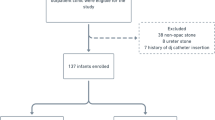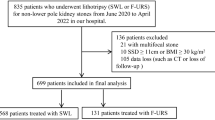Abstract
To outline the current status of Shock Wave Lithotripsy (SWL) in stone treatment and the changes in the mode of application after the COVID-19 pandemic along with critical factors affecting the clinical practice of this particular procedure. This study targeted national and international urology experts who could share and contribute their experiences and perspectives on SWL practices after COVID-19 era. Approximately 650 urology specialists were invited to participate in the survey based study via Google Forms. Participation was voluntary and 398 of the invited participants completed the survey, yielding an acceptable response rate of approximately 61.23%. This survey highlights significant findings that shed light on the changes in clinical SWL applications. Nearly half of SWL procedures are performed by technicians or nurses instead of experienced urologists, potentially affecting the proper application and outcomes of the procedure. SWL seemed to be applied on a guideline (GL) indications based manner by the majority of the participants. Fluoroscopy remains still as the most commonly used method for radiological assessment, underscoring the necessity to teach sonography applications to younger urologists. Key reasons for the limited clinical application of SWL include the absence of lithotripters in the departments, high lithotriptor costs and significantly lower reimbursement rates compared to PNL and fURS modalities. Finally, an increase in SWL utilization rates has been observed post-COVID-19, highlighting its certain advantages realized during this period. These findings provide important insights into the role of SWL in stone treatment and the main factors influencing its clinical application practices. Although the popularity of SWL in the management of urinary stones is being stated to decline particularly in the last two decades, data obtained in this survey emphasized well that it is still a viable option especially for stones smaller than 15 mm. Our findings highlight the enduring relevance of SWL in contemporary stone therapy protocols in the context of COVID-19, where outpatient, non-invasive procedures are preferred. In addition to the consideration of certain factors affecting the rate of its application in clinical practice, to achieve high success rates with minimal complications in SWL, strategic patient selection and adherence to procedure guidelines seem to be crucial.




Similar content being viewed by others
Explore related subjects
Discover the latest articles and news from researchers in related subjects, suggested using machine learning.Data availability
No datasets were generated or analysed during the current study.
References
Schmiedt E, Chaussy C (1984) Extracorporeal shock-wave lithotripsy (ESWL) of kidney and ureteric stones. Int Urol Nephrol 16(4):273–283. https://doi.org/10.1007/BF02081861
Türk C, Neisius AA, Petrik A, Seitz C, Skolarikos KTA, Donaldson JF, Grivas N (2018) EAU guidelines on urolithiasis. Europ Assoc Urol 32:158
Assimos D, Krambeck A, Miller NL et al (2016) Surgical management of stones: American urological association/endourological society guideline. PART II J Urol 196(4):1161–1169. https://doi.org/10.1016/j.juro.2016.05.091
Lantz AG, McKay J, Ordon M, Pace KT, Monga M, Honey RJ (2016) Shockwave lithotripsy practice pattern variations among and between american and canadian urologists in support of guidelines. J Endourol 30(8):918–922. https://doi.org/10.1089/end.2016.0153
Yildirim K, Olcucu MT, Colak ME (2018) Trends in the treatment of urinary stone disease in Turkey. PeerJ 6:e5390. https://doi.org/10.7717/peerj.5390
Ates F, Zor M, Yılmaz O et al (2016) Management behaviors of the urology practitioners to the small lower calyceal stones: the results of a web-based survey. Urolithiasis 44(3):277–281. https://doi.org/10.1007/s00240-015-0825-x
Proietti S, Somani BK, Pietropaolo A et al (2018) Italian endourological panorama: results from a national survey. Central European J Urol 71(2):190–195. https://doi.org/10.5173/ceju.2018.1623
Sharma NL, Alexander CE, Grout E, Turney BW (2017) Shock-wave lithotripsy: variance within UK practice. Urolithiasis 45(2):193–201. https://doi.org/10.1007/s00240-016-0886-5
Li K, Lin T, Zhang CE, al, (2013) Optimal frequency of shock wave lithotripsy in urolithiasis treatment: a systematic review and meta-analysis of randomized controlled trials. J Urol 190(4):1260–1267. https://doi.org/10.1016/j.juro.2013.03.075
Semins MJ, Trock BJ, Matlaga BR (2008) The effect of shock wave rate on the outcome of shock wave lithotripsy: a meta-analysis. J Urol 179(1):194–197. https://doi.org/10.1016/j.juro.2007.08.173
Koo V, Beattie I, Young M (2010) Improved cost-effectiveness and efficiency with a slower shockwave delivery rate. BJU Int 105(5):692–696. https://doi.org/10.1111/j.1464-410X.2009.08919.x
Pishchalnikov YA, Neucks JS, VonDerHaar RJ, Pishchalnikova IV, Williams JC Jr, McAteer JA (2006) Air pockets trapped during routine coupling in dry head lithotripsy can significantly decrease the delivery of shock wave energy. J Urol 176(6 Pt 1):2706–2710. https://doi.org/10.1016/j.juro.2006.07.149
Jain A, Shah TK (2007) Effect of air bubbles in the coupling medium on efficacy of extracorporeal shock wave lithotripsy. Eur Urol 51(6):1680–1687. https://doi.org/10.1016/j.eururo.2006.10.049
Kamel M, Salem EA, Maarouf A, Abdalla M, Ragab A, Shahin AM (2015) Supine transgluteal vs prone position in extracorporeal shock wave lithotripsy of distal ureteric stones. Urology 85(1):51–54. https://doi.org/10.1016/j.urology.2014.08.033
Galli R, Sighinolfi MC, Micali S, Martorana E, Rosa M, Mofferdin A, Bianchi G (2017) Advantages of the supine transgluteal approach for distal ureteral stone extracorporeal shock wave lithotripsy: outcomes based on CT characteristics. Minerva Urol E Nefrol Italian J Urol Nephrol 69(2):189–194. https://doi.org/10.23736/S0393-2249.16.02741-7
Choo MS, Han JH, Kim JK, Shin TY, Lee WK, Lee SK, Lee SH (2018) Author correction to: the transgluteal approach to shockwave lithotripsy to treat distal ureter stones: a prospective, randomized, and multicenter study. World J Urol 36(8):1307. https://doi.org/10.1007/s00345-018-2289-4
Ethics declarations
Conflict of interests
The authors declare no competing interests.
Additional information
Publisher's Note
Springer Nature remains neutral with regard to jurisdictional claims in published maps and institutional affiliations.
Rights and permissions
Springer Nature or its licensor (e.g. a society or other partner) holds exclusive rights to this article under a publishing agreement with the author(s) or other rightsholder(s); author self-archiving of the accepted manuscript version of this article is solely governed by the terms of such publishing agreement and applicable law.
About this article
Cite this article
Erdoğan, E., Sarıca, G., Şahin, C. et al. Actual clinical practice pattern in SWL after COVID-19 era: a critical evaluation from different aspects. Urolithiasis 52, 155 (2024). https://doi.org/10.1007/s00240-024-01650-8
Received:
Accepted:
Published:
DOI: https://doi.org/10.1007/s00240-024-01650-8




